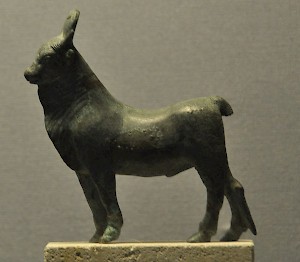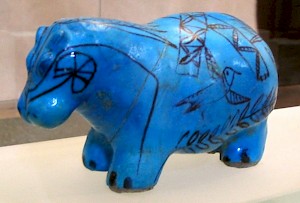Herodotus, bk 2, logos 5
Herodotus of Halicarnassus (c.480-c.429 BCE): Greek researcher, often called the world's first historian. In The Histories, he describes the expansion of the Achaemenid Empire under its kings Cyrus the Great, Cambyses, and Darius I the Great, culminating in Xerxes' expedition to Greece (480 BCE), which met with disaster in the naval engagement at Salamis and the battles at Plataea and Mycale. Herodotus' book also contains ethnographic descriptions of the peoples that the Persians have conquered, fairy tales, gossip, and legends.
Egyptian customs and animals (2.35-99)

In the next logos, Herodotus tells us about the customs of the Egyptians. These are often inversions of Greek customs: women attend market and men do the weaving, the priests shave their hair, they knead dough with their feet and clay with their hands, women urinate standing up and men do it sitting down (text).
Next, we learn about the religion and the festivals of the country along the Nile, which cause Herodotus to digress on the temple of Heracles in Tyre; and Herodotus concludes with a description of the animals that live in Egypt, such as the holy bull Apis, the holy cats, the holy crocodiles, the hippopotamus, the phoenix and the cobra. Then, Herodotus returns to the Egyptian customs, and explains - among other things - how mummies are made (text).
Comment
Many Egyptian customs described by Herodotus are the reversal of a custom that existed in Greece. The explanation is that the ancient Greeks believed that the barbarians on the edges of the earth were the opposite of the civilized people in the middle of the terrestrial disk. Herodotus' description tells a lot more about ancient Greece than about the Egyptians.
Herodotus knows more about the Egyptian religion than he finds proper to write down. E.g., he mentions nearly all elements of the legend of Isis and Osiris in passing, but never tells the complete story. (It is known to us from a treatise by the Greek author Plutarch of Chaeronea, who lived c.100 CE.) When Herodotus describes the festivals, sacrifices and rituals of famous Egyptian temples like Memphis, Sais, and Heliopolis, he can seldom been shown to err.

His way of describing the holy animals is pretty accurate, but one cannot help but wonder if he ever saw a hippopotamus. His description is closer to a horse with tusks than to the hippo. Now it turns out that at this point, Herodotus is guilty of plagiarism.note Perhaps the Halicarnassian researcher has seen the hippo only from a distance and has decided not to trust his defective observation and to rely on another source, Hecataeus of Miletus (see below).
Although egyptologists regard this logos as a valuable source of information, the accuracy of it has been challenged. His eyewitness accounts seem accurate, but the stories told to him are questioned. Some researchers think that the people who told Herodotus information could have forgotten parts, or just entertained him with an interesting answer that had nothing to do with the truth.